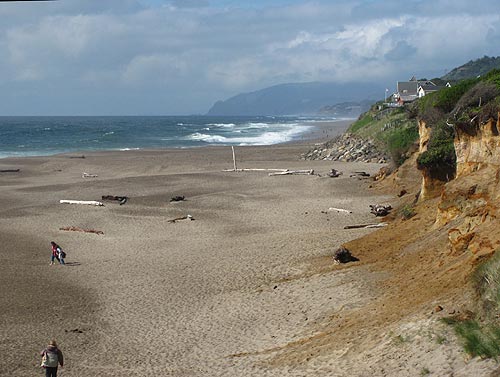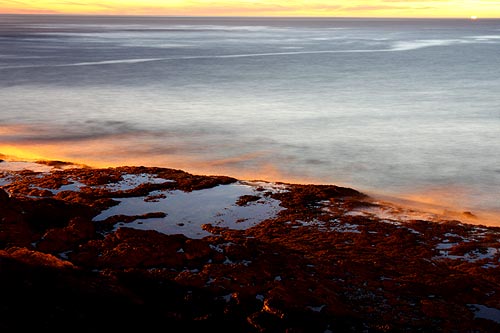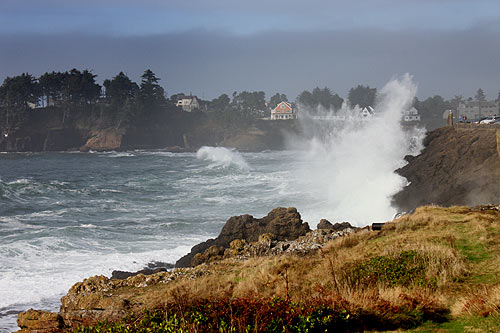 |
Updated: Scientists Study Why Some Whales Don't Leave Oregon Coast
Published 08/05/2015 at 5:25 AM PDT - Updated 08/05/2015 at 3:25 PM PDT
By Oregon Coast Beach Connection staff

(Depoe Bay, Oregon) – It seems humans aren't the only ones making a tourist destination out of the Oregon coast, as well as stopping over to gobble down a lot of seafood. A significant number of gray whales are straying from the annual migrations between Mexico and southern Canada to hang out off these shores for a long period of time. (Updated: researchers at the Boiler Bay lookout said they will welcome pubic interaction).
There are some 200 so-called resident whales who linger here (out of the 20,000 in migration), mostly during the summer, apparently to stuff themselves in a kind of mysid shrimp all-you-can-eat buffet. They divert their attention here and leave those migrations between the breeding grounds of Baja, Mexico and the feeding areas of British Columbia and Alaska.
Scientists from Oregon State University and the Hatfield Marine Science Center in Newport want to know why. Now, OSU's Florence van Tulder and other researchers are planting themselves at Port Orford and at Depoe Bay to track the behavior and movements of gray whales, while comparing them with photo archives of previous long-term visitors.
Part of the study also includes monitoring how vessels may interact with them, including commercial, charter and recreational boats, along with even the whale watching tours.
It's possible these boats may have an effect on their behavior, van Tulder said, and the group may make future recommendations to vessels based on those observations.
Van Tulder, who is a master's student in OSU’s Department of Fisheries and Wildlife in OSU’s College of Agricultural Sciences, said the group will be using a surveyor’s instrument called a theodolite to track and map the movement of individual whales at a fine scale as they forage. They'll be closely examining the feeding patterns as the whales look for food patches.
Food has long been considered the main factor behind resident whales, according to whale tours and the Whale Watch Center in Depoe Bay. But there could be other factors.
“We think the reason they’re attracted to these foraging hotspots along the Oregon coast is an abundance of mysid shrimp,” van Tulder said. “During summer months, the mysid can be really dense, from the seafloor to the surface, and really close to the shore. We want to know if this wealth of foraging is enough to get them to disrupt their migration north. Or is there some other mechanism at work that makes 200 whales act differently than the other 20,000? That’s what we hope to find out.”
Van Tulder said scientists don't even know how they locate the shrimp.
“Gray whales don’t use echo-location, so how do these whales search for and find dense prey patches?,” she said. “It may be possible that this knowledge is passed along from mother to calf among this population subset.”
Leigh Torres, an OSU whale specialist with the Marine Mammal Institute who is van Tulder’s mentor for the project, said this research could finally reveal much that has been a mystery about these local cetaceans. Do foraging strategies change with calves around? Do they behave differently to different types of boats?
“Whales might react to some boats, but perhaps not others based on speed, approach, motor type, etc.,” Torres said.
Then there is the mystery of whether or not this group of 200 whales is getting bigger Torres said it's possible more are joining the buffet, or that other whales have done this in the past but stopped for some reason.
“Or it may be that some whales are just opportunistic and want to stick around and chow down on the shrimp. With a long-term study, we hope to find out,” Torres said.
More about the Depoe Bay area below. More about Oregon Coast Science.




More About Oregon Coast hotels, lodging.....
More About Oregon Coast Restaurants, Dining.....
LATEST Related Oregon Coast Articles
Oregon Coast, Valley and Likely Washington Coast to Get Some Aurora Borealis ... |
Back to Oregon Coast
Contact Advertise on BeachConnection.net
All Content, unless otherwise attributed, copyright BeachConnection.net Unauthorized use or publication is not permitted
Secrets of the Season |
Unusual Travel Articles TravelParanormal.com allows you to submit your own creepy tale or debunk one - or see up-to-the-minute news headlines about travel and the paranormal. News Headlines from All Over Oregon Need to scan Oregon headlines? Constantly updated news from all over Oregon: a comprehensive, up-to-the-minute display of news headlines from a variety of media Oregon Coast Oceanfront Lodging, Hotels, Rentals |






































